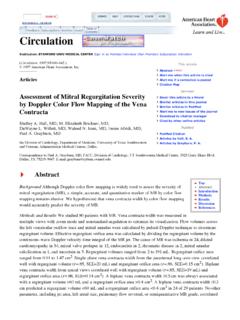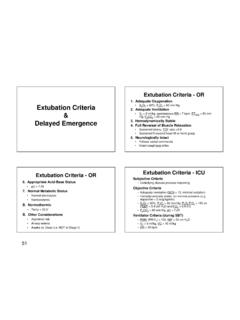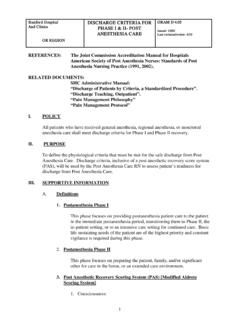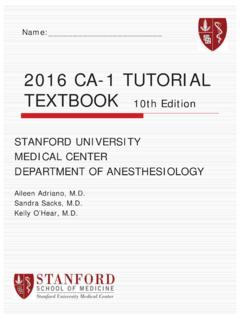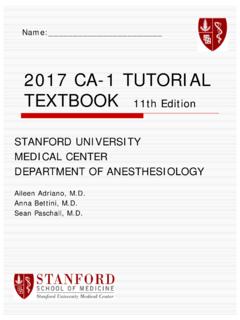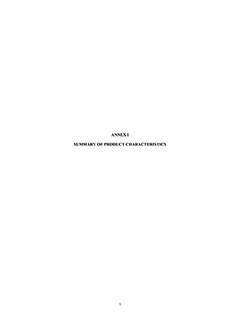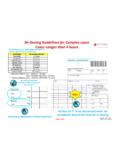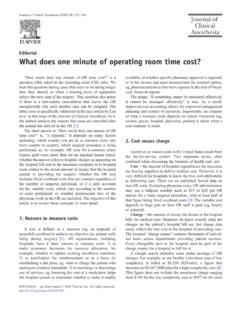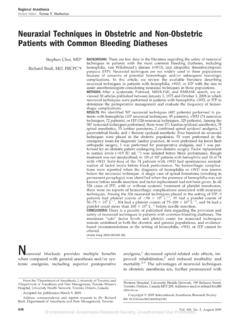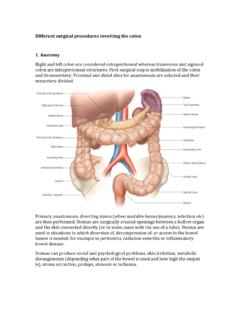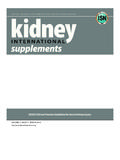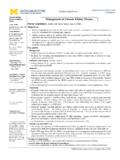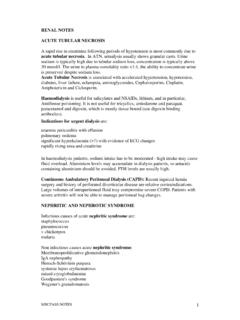Transcription of REVIEW ARTICLE Benefits and risks of furosemide in …
1 REVIEW ARTICLEB enefits and risks of furosemide in acute kidney injuryK. M. Ho1and B. M. Power21 Intensive Care Specialist, Royal Perth Hospital and Clinical Associate Professor, University of Western Australia, Perth,WA, Australia2 Intensive Care Specialist, Joondalup Hospital, Perth, WA, AustraliaSummaryFurosemide, a potent loop diuretic, is frequently used in different stages of acute kidney injury, butits clinical roles remain uncertain. This REVIEW summarises the pharmacology of furosemide , itspotential uses and side effects, and the evidence of its efficacy.
2 furosemide is actively secreted bythe proximal tubules into the urine before reaching its site of action at the ascending limb of loop ofHenle. It is the urinary concentrations of furosemide that determine its diuretic effect. The severityof acute kidney injury has a significant effect on the diuretic response to furosemide ; a good urinary response may be considered as a proxy for having some residual renal function. Thecurrent evidence does not suggest that furosemide can reduce mortality in patients with acutekidney injury. In patients with acute lung injury without haemodynamic instability, furosemidemay be useful in achieving fluid balance to facilitate mechanical ventilation according to thelung-protective ventilation to: Kwok M.
3 HoE-mail: 1 December 2009 acute kidney injury (AKI) is a serious medical conditionwith significant mortality and morbidity [1]. The causesof AKI include infection, hypovolaemia, cardiac insuffi-ciency, and nephrotoxins such as aminoglycoside antibi-otics and radiocontrast agents. Despite advances intechniques and technologies in renal replacement therapy,mortality associated with AKI has remained largelyunchanged over the past decade [2].Non-oliguric AKI is well known to be associated witha better prognosis than oliguric AKI [3], and as such, non-oliguric AKI is classified separately from oliguric AKIaccording to the AKI RIFLE (Risk, Injury, Failure, Loss,and End-stage) criteria suggested by the acute DialysisQuality Initiative (ADQI) group [4].
4 Because oliguria is arisk factor or marker of poor outcomes in AKI and alsomakes fluid and electrolyte management more difficult,many clinicians use high doses of intravenous furosemideto increase urine output or in an attempt to convertoliguric to non-oliguric AKI. Although furosemide iswidely used in different stages of AKI, its clinical roles andeffectiveness remain uncertain and controversial [5 15].Randomised controlled trials are of pivotal importancein guiding clinicians daily practice, but pharmacologicalprinciples, experimental data, and clinical observationsare also important [16], especially when the evidencefrom randomised controlled trials is inconclusive.
5 Thisnarrative REVIEW aims to provide an update on thepotential roles of furosemide in AKI by summarising itspharmacological properties, side effects, and evidence ofeffectiveness from randomised controlled the literature search for relevant articles inMEDLINE and EMBASE databases before 20 November2009, the following search terms, acute renal failure , acute kidney injury , dialysis , renal replacement ther-apy , tumour lysis syndrome , hypercalcaemia , haemo-globinuria , contrast , drug interaction , side effects , prevention , prognosis , or therapy with furosemide were used without any language restrictions.
6 Relevantreferences from the articles identified from the literaturesearch were also retrieved for further the REVIEW on pharmacological properties of furo-semide, both animal and human data were used withoutpooling the data by quantitative methods. As for theassessment of effectiveness of furosemide , only rando-mised controlled trials comparing furosemide with aplacebo to prevent or treat AKI published before 20 Anaesthesia, 2010,65, pages 283 293 2010 The AuthorsJournal compilation 2010 The Association of Anaesthetists of Great Britain and Ireland283 November 2009 were included.
7 We updated the resultsof our previous meta-analysis [17], using the same studyinclusion and exclusion criteria and methodology. In thisreview only the effect of furosemide on the risk ofrequiring renal replacement therapy and mortality of furosemideFurosemide is a weak organic acid. It is predominantlycleared by the kidneys (85%) in which about half ismetabolised, and half is actively secreted in an unchangedform [18] by the organic acid transporters in the proximaltubules (Fig. 1). The normal systemic clearance offurosemide is about 19 ) )1(Table 1) [18].
8 furosemide is highly protein bound (> 98%) and onlya very small fraction of the drug can be filtered throughthe glomerulus [19]. The binding of furosemide to plasmaproteins facilitates its renal tubular secretion and diureticeffect [20]. A reduction in the protein-bound fractionof furosemide in hypoalbuminaemia or in the presenceof another highly protein-bound drug ( warfarin,phenytoin) reduces the tubular secretion of furosemideand its diuretic effect [20 22], and at the same timeincreases its metabolic clearance. Hence, the presence of ahighly protein-bound drug and hypoalbuminaemia canboth contribute to resistance to the diuretic effect offurosemide.
9 These experimental findings are supported bythe clinical observation of an enhanced diuretic responseto furosemide when concomitant albumin administrationis used in patients with hypoproteinaemia [23]. furosemide acts on the sodium-chloride-potassium[Na-K-Cl2] co-transporters at the intra-luminal side ofthe ascending limb of the loop of Henle (Fig. 1). Theaccumulation of ions inside the lumen of renal tubulesafter administration of furosemide inhibits the passivere-absorption of potassium, calcium and magnesium,resulting in increased urinary losses of these has also been shown to block the tubulo-glomerular feedback response [24].
10 There are threedeterminants of diuretic response to furosemide : theurinary concentrations of furosemide ; the time of deliveryof furosemide to the site of action; and the dynamics ofthe response at the site of action [19]. The urinaryconcentration of furosemide can be reduced in the pres-ence of other organic acids that compete for the organicFigure 1 Delivery of furosemide by the proximal tubule to its site of action at the loop of 1 Pharmacology of organic acid secreted by organic acid transporters in the proximal tubules into the urineClearance = 19 ) )
